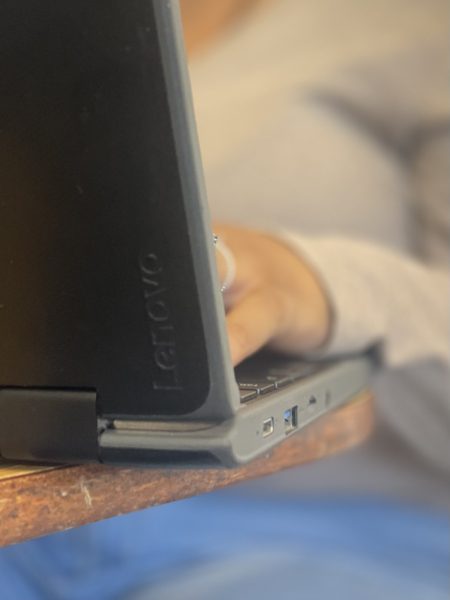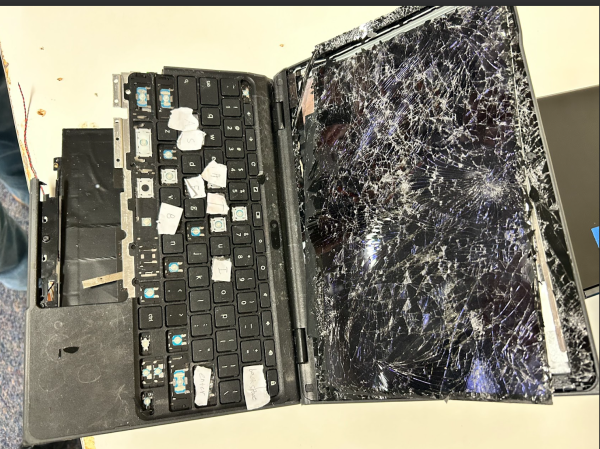During the pandemic, school districts were forced to supply Chromebooks for students across the nation, purchasing thousands per district. Now, the question should be asked, why did the district choose Lenovo over other brands?
Prior to the pandemic, the Lucia Mar School District used a variation of different brands of laptops, before having the 1:1 ratio instituted during the pandemic. This ratio aims to have a Chromebook for every student within the district and pushed the district to buy cheaper and better functioning technology.
“We started with Samsung in 2013 and then Dell in 2014,” Executive Director of ITS Allan Havemose said. “Then in 2015, we tried HP, and we added a newer generation of Samsungs at that time. [Finally], in 2018, is when we started with Lenovo.”
Different sources provided conflicting information about the switch to Lenovo.
“It was actually not a technical decision at all,” Havemose said “The instructional team wanted the stylus and neither HP nor Dell had styluses.”
On the other hand, Ashley Smith, Director of 21st Century Learning stated the reasoning behind the switch was due to costs.
“When we were researching the devices at the time, [Lenovo] had a better price point compared to quality, so [Lenovo] is a best bang for your buck kind of thing,” Smith said.
While there may have been multiple reasons for the Lenovo purchase, one didn’t hold up—best price. After accessing the purchasing records and comparison sheets, Lenovo was the most expensive Chromebook compared to Acer Chromebook and Samsung Chromebook.

One of the main arguments for continuing to purchase from Lenovo is the fact that the district has a surplus of students and needs to continuously fix the devices when they break.
“We are entirely focused on having functionality, I mean, if you think about it holistically, we have 10,000 students and roughly 2,000 staff, so we’re at 12,000 Chromebooks,” Havemose said.
Since 2020, the Lucia Mar School District has purchased an estimated 8,000 pieces of technology from Lenovo, and has recently purchased another 500 Chromebooks, which Havemose estimates should last the district to Christmas of 2024.
Pricing, performance, and durability all play a role in the district’s purchasing decisions. Environmental sustainability and sources of labor were not.
In 2020, Lenovo used child and forced labor in their supply chain. The company continues to use Uyghur workers under forced labor conditions in factories in China, according to the Australian Strategic Policy Institute.
The district purchased a batch of Lenovo laptops during the pandemic, which were then held up in the shipping process while other brands they purchased from were not.
“We had an issue with Lenovo devices specifically because we were also able to continue buying Samsung Chromebooks at the time. We were able to ascertain the particulars of why that was, and it was because the subcontractor that Lenovo uses within China was flagged for the use of prison labor,” Christopher Ryan said. “All of the devices that were in transit were held up and it was across the country. There was hundreds of thousands of devices that were functionally locked away.”
The problem became clear to both district and IT employees as they received notification of the cause of the hold up from the US Government.
“We were apprised that there was a problem. It wasn’t just, ‘hey, we’re not sure, they didn’t make their boats or there’s not enough people to offload the containers in Long Beach’ or if there was a strike or something like that. No, it was a specific act of the US government to prevent them from being released,” Ryan said “The communication [for why the Lenovo laptops were held up] was transmitted to everybody that had orders outstanding, with [information about] the vendor that was flagged as being problematic and that they functionally received communication and a formal letter ‘Hey, you have an order and these are held up and this is the reason why.’”
The curriculum department focused on functionality when choosing devices, despite knowing about the ethical concerns.
“My conversations have always been about feature and function and price … I think that [labor practice] is a good question, but from my perspective that has not been brought up,” Havenmose said in regards to ethical concerns with Lenovo.
While feature and functionality may be the most prioritized qualifications by purchasers from the district, it seems that even this may lack in superiority compared to alternative available products.
“In terms of the design of the devices themselves, we have seen better design and functionality from vendors other than Lenovo, specifically, Samsung, and Acer devices. They have been in for testing and evaluation and their components, and the design and the user interface and everything we felt was superior to the Lenovo devices,” Ryan said. “One of the things that the curriculum department determined is that they wanted to exclusively provide touchscreen Chromebooks despite the technology group, asking whether that was in fact a priority for all users across the entire system.”

LMUSD continues to purchase Lenovo despite other options that are arguably superior. These devices, like others, come with many problems.
“The most common problem [with Lenovo laptops] is that the WiFi stops working and also been seeing a lot of keyboard issues this year where certain keys, like commonly used keys, stop working,” AGHS librarian Rachel Lodge said.
Students have encountered other problems with the Lenovo technology.
“One of the issues that we have with Lenovo devices is when we have any damage to the touchscreen or digitizer. The only resolution that we have is to take parts from another device and Frankenstein them together, because the cost of buying the parts in order to replace the screens is prohibitive, and therefore, we have to eat the whole animal as it were,” Ryan said.
Other devices previously purchased by the district had an easier and cheaper screen to repair due to lack of a touchscreen.
“The other device that we were using or used in the past, a non touchscreen Chromebook, we had the ability to replace the screen at a nominal cost. When we started [fixing those devices] in the early part of the shutdown, we were getting the screens themselves for about $30 apiece and as the supply chain issues started to become more prevalent and pronounced the price rose to like $40 a screen,” Ryan said.
On the other hand, Lenovos were described as easier to repair.
“One of the things about the Lenovo we like is that we can open it. And on a typical year we’ll have 1500 Chromebooks come in for repair,” Havemose said.

Prior to purchasing Lenovo, the different schools within LMUSD used Samsung, but once the district became involved in 2018, they pushed Lenovo. One of the original reasons was due to the inclusion of a stylus as part of the design, an inclusion that students don’t typically use.
“We started purchasing the devices when the district became involved as opposed to the sites specifically being the ones to purchase the devices. Most of the Samsung 3 Chromebooks that Arroyo Grande had at the time, were all purchased under the purchasing of Arroyo Grande and the Lenovo 500 generation [Chromebooks] we got in 2018 were supplied by the district,” Ryan said.
Overall, purchasing Chromebooks on a massive scale can have massive environmental, economic, and ethical implications; implications that should all be considered.
“By choosing Chromebooks is choosing to invest in technology that within roughly five to seven years, is all going to be sent to E waste and therefore it needs to be recycled in some way, shape or form. [Purchasing Chromebooks in bulk] is not very good for the environment. The materials that go into those then have to be recovered as part of the waste chain. Now, the the reason why [the district] chose Chromebooks is because they’re more affordable than things that run Mac OS or Windows,” Ryan said.
District funding pays for all of LMUSD’s technology purchases, allowing the district only a certain amount to cover all students, yet not all students choose to use the district provided laptops.
“Many of the students that I interact with, touch their school issued devices during the mandatory testing times and no other times, and so that’s not a great use of a resource,” Ryan said.
Providing all students from first to twelfth grade with laptops allows the district to state they have a one to one ratio, but is it necessary when many students don’t use these devices?







